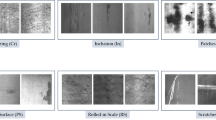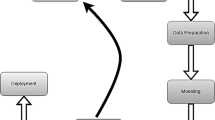Abstract
Over the last few years, advanced deep learning-based computer vision algorithms are revolutionizing the manufacturing field. Thus, several industry-related hard problems can be solved by training these algorithms, including flaw detection in various materials. Therefore, identifying steel surface defects is considered one of the most important tasks in the steel industry. In this paper, we propose a deep learning-based model to classify six of the most common steel strip surface defects using the NEU-CLS dataset. We investigate the effectiveness of two state-of-the-art CNN architectures (MobileNet-V2 and Xception) combined with the transfer learning approach. The proposed approach uses an ensemble of two pre-trained state-of-the-art Convolutional Neural Networks, which are MobileNet-V2 and Xception. To perform a comparative analysis of the proposed architectures, several evaluation metrics are adopted, including loss, accuracy, precision, recall, F1-score, and execution time. The experimental results show that the proposed deep ensemble learning approach provides higher performance achieving an accuracy of 99.72% compared to MobileNet-V2 (98.61%) and Xception (99.17%) while preserving fast execution time and small models’ size.







Similar content being viewed by others
References
Ashour M, Fatimah K, Abdul Halin A, Abdullah L, Darwish S (2019) Surface defects classification of hot-rolled steel strips using multi-directional Shearlet features. Arab J Sci Eng 44:2925–2932. https://doi.org/10.1007/s13369-018-3329-5
Tang W-P, Liong S-T, Chen C-C, Tsai M-H, Hsieh P-C, Tsai Y-T, Chen S-H, Wang K-C (2021) Design of multi-receptive field fusion-based network for surface defect inspection on hot-rolled steel strip using lightweight dataset. Appl Sci 11(20). https://doi.org/10.3390/app11209473
Song K, Yan Y (2013) A noise robust method based on completed local binary patterns for hot-rolled steel strip surface defects. Appl Surf Sci 285:858–864. https://doi.org/10.1016/j.apsusc.2013.09.002
Mentouri Z, Moussaoui A, Boudjehem D, Hakim D (2018) Steel strip surface defect identification based on binarized statistical features. UPB Sci Bull Ser B Chem Mater Sci 80:145–156
Zaghdoudi R, Seridi H, Boudiaf A, Ziani S (2020) Binary Gabor pattern (BGP) descriptor and principal component analysis (PCA) for steel surface defects classification. In: 2020 international conference on advanced aspects of software engineering (ICAASE). https://doi.org/10.1109/ICAASE51408.2020.9380108, pp 1–7
Aslan MF, Sabanci K, Durdu A, Unlersen MF (2022) COVID-19 diagnosis using state-of-the-art CNN architecture features and Bayesian Optimization. Comput Biol Med 142:105244. https://doi.org/10.1016/j.compbiomed.2022.105244
Bouguettaya A, Zarzour H, Kechida A, Taberkit AM (2021) Vehicle detection from UAV imagery with deep learning: a review. IEEE Trans Neural Netw Learn Syst, 1–21. https://doi.org/10.1109/TNNLS.2021.3080276
Kheradmandi N, Mehranfar V (2022) A critical review and comparative study on image segmentation-based techniques for pavement crack detection. Construct Build Mater 321:126162. https://doi.org/10.1016/j.conbuildmat.2021.126162
Wan X, Zhang X, Liu L (2021) An improved VGG19 transfer learning strip steel surface defect recognition deep neural network based on few samples and imbalanced datasets. Appl Sci 11(6). https://doi.org/10.3390/app11062606
Jain S, Seth G, Paruthi A, Soni U, Kumar G (2022) Synthetic data augmentation for surface defect detection and classification using deep learning. J Intell Manuf 33. https://doi.org/10.1007/s10845-020-01710-x
Wang W, Lu K, Wu Z, Long H, Zhang J, Chen P, Wang B (2021) Surface defects classification of hot rolled strip based on improved convolutional neural network. ISIJ Int 61(5):1579–1583. https://doi.org/10.2355/isijinternational.ISIJINT-2020-451
Li S, Wu C, Xiong N (2022) Hybrid architecture based on CNN and transformer for strip steel surface defect classification. Electronics 11(8). https://doi.org/10.3390/electronics11081200
LeCun Y, Bottou L, Bengio Y, Haffner P (1998) Gradient-based learning applied to document recognition. Proc IEEE 86(11):2278–2324. https://doi.org/10.1109/5.726791
Krizhevsky A, Sutskever I, Hinton GE (2017) Imagenet classification with deep convolutional neural networks. Commun ACM 60(6):84–90. https://doi.org/10.1145/3065386
Simonyan K, Zisserman A (2014) Very deep convolutional networks for large-scale image recognition. arXiv:1409.1556
Szegedy C, Liu W, Jia Y, Sermanet P, Reed S, Anguelov D, Erhan D, Vanhoucke V, Rabinovich A (2015) Going deeper with convolutions. In: 2015 IEEE conference on computer vision and pattern recognition (CVPR), pp 1–9. https://doi.org/10.1109/CVPR.2015.7298594
He K, Zhang X, Ren S, Sun J (2016) Deep residual learning for image recognition. In: Proceedings of the IEEE conference on computer vision and pattern recognition, pp 770–778. https://doi.org/10.1109/CVPR.2016.90
Sandler M, Howard A, Zhu M, Zhmoginov A, Chen L-C (2018) Mobilenetv2: Inverted residuals and linear bottlenecks. In: 2018 IEEE/CVF conference on computer vision and pattern recognition, pp 4510–4520. https://doi.org/10.1109/CVPR.2018.00474
Howard A, Sandler M, Chen B, Wang W, Chen L-C, Tan M, Chu G, Vasudevan V, Zhu Y, Pang R, Adam H, Le Q (2019) Searching for MobileNetv3. In: 2019 IEEE/CVF international conference on computer vision (ICCV), pp 1314–1324. https://doi.org/10.1109/ICCV.2019.00140
Howard AG, Zhu M, Chen B, Kalenichenko D, Wang W, Weyand T, Andreetto M, Adam H (2017) MobileNets: efficient convolutional neural networks for mobile vision applications. arXiv:1704.04861
Iandola F, Han S, Moskewicz M, Ashraf K, Dally W, Keutzer K (2016) SqueezeNet: Alexnet-level accuracy with 50x fewer parameters and < 0.5mb model size
Szegedy C, Ioffe S, Vanhoucke V, Alemi AA (2017) Inception-v4, inception-resnet and the impact of residual connections on learning. In: Proceedings of the 31st AAAI conference on artificial intelligence. AAAI’17. AAAI Press, pp 4278–4284
Chollet F (2016) Xception: deep learning with depthwise separable convolutions. arXiv. https://doi.org/10.48550/ARXIV.1610.02357
Chollet F (2017) Xception: Deep learning with depthwise separable convolutions. In: 2017 IEEE conference on computer vision and pattern recognition (CVPR), pp 1800–1807. https://doi.org/10.1109/CVPR.2017.195
Yi L, Li G, Jiang M (2017) An end-to-end steel strip surface defects recognition system based on convolutional neural networks. Steel Res Int 88(2):176–187. https://doi.org/10.1002/srin.201600068
Hao Z, Li Z, Ren F, Lv S, Ni H (2022) Strip steel surface defects classification based on generative adversarial network and attention mechanism. Metals 12(2). https://doi.org/10.3390/met12020311
Funding
Funding The authors declare that no funds, grants, or other support were received during the preparation of this manuscript.
Author information
Authors and Affiliations
Corresponding author
Ethics declarations
Conflict of interest
The authors declare no competing interests.
Additional information
Author contributions
All authors contributed to the study conception and design. Material preparation, data collection, and analysis were performed by Abdelmalek Bouguettaya, Zoheir Mentouri, and Hafed Zarzour. The first draft of the manuscript was written by Abdelmalek Bouguettaya and all authors commented on previous versions of the manuscript. All authors read and approved the final manuscript.
Data availability
The dataset used in this study is publicly available at https://doi.org/10.1016/j.apsusc.2013.09.002.
Consent to participate
Not applicable
Publisher’s note
Springer Nature remains neutral with regard to jurisdictional claims in published maps and institutional affiliations.
Abdelmalek Bouguettaya, Zoheir Mentouri and Hafed Zarzour contributed equally to this work.
Rights and permissions
Springer Nature or its licensor (e.g. a society or other partner) holds exclusive rights to this article under a publishing agreement with the author(s) or other rightsholder(s); author self-archiving of the accepted manuscript version of this article is solely governed by the terms of such publishing agreement and applicable law.
About this article
Cite this article
Bouguettaya, A., Mentouri, Z. & Zarzour, H. Deep ensemble transfer learning-based approach for classifying hot-rolled steel strips surface defects. Int J Adv Manuf Technol 125, 5313–5322 (2023). https://doi.org/10.1007/s00170-023-10947-8
Received:
Accepted:
Published:
Issue Date:
DOI: https://doi.org/10.1007/s00170-023-10947-8




